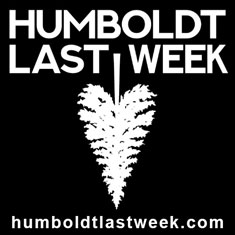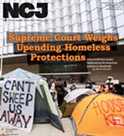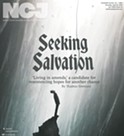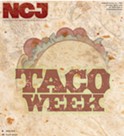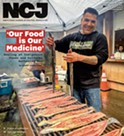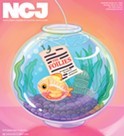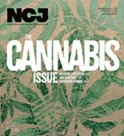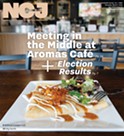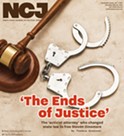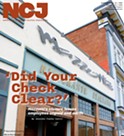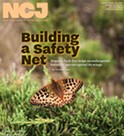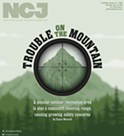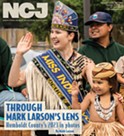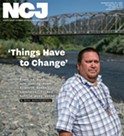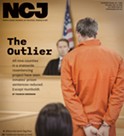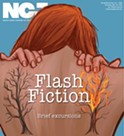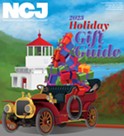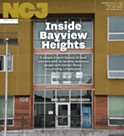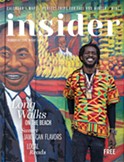The Light on the Bluff
Their compound is razed, but memories of the Jesus people linger
By Heidi Walters[
{
"name": "Top Stories Video Pair",
"insertPoint": "7",
"component": "17087298",
"parentWrapperClass": "fdn-ads-inline-content-block",
"requiredCountToDisplay": "1"
}
]
The young man stands at the edge of Table Bluff, gazing west into one of the greatest of romances: Rumpled ocean kissing moody sky, wind-embraced, fog-enswirled, sun-glinted. His head, too, is aswirl, with passionate thought.
Beside him is a giant cross. Behind, beyond the path he has just wandered, are decrepit white-washed buildings, a water tower, vegetable gardens abounding with Swiss chard, and a lot full of shabby cars. Closer, right at his back, a lighthouse looms, its flashing white light poised to pierce fog, dusk and night.
[][][]
Table Bluff is a blank. Cleared, empty. That compound of old white buildings and tall water tower, on the west end where Table Bluff Road turns sharply north along a row of shaggy cypress before dropping down to the South Spit? Some of it there since the 1890s? It's all gone now: The last buildings were picked apart and hauled away and the land scraped clean in mid-October by Bureau of Land Management contractors.
With the buildings went the last physical reminders on the land of one of the more curious -- and possibly most influential -- periods on Table Bluff. Not the time of the lighthouse, the Navy wireless station or even the wartime beach patrol outpost and lookout, important as those were.
We're talking about later, when hundreds of wandering young people swarmed in by junker or thumbed rides to occupy the abandoned government structures and, many quickly found, to be saved if that was their destiny. Those who stayed became a major force in the Jesus People Movement that swept the country in the 1970s, and they built a powerful denomination of born-again Christianity, Gospel Outreach, that would leap from the bluff, scatter and plant itself throughout the world.
[][][]
It's June 28, 1971, and the young man -- he is 24 -- looks of his time: skinny, bearded, on-the-road. A recent dropout of Rutgers graduate school in photochemistry -- he doesn't need to spend three years with his head stuck in mathematics books -- he's wandered 10,000 miles around the U.S and Canada. If he could just find a nice, quiet enough place, he might figure out where he belongs in the world, and what he believes. Four months have gone by. Home, Portland, Ore., is now a day away. The hitchhikers he picked up in Fortuna the day before brought him here. He's been fed. He's rested. His curtain-windowed Ford Falcon station wagon, which he'd parked the day before in the lot that once was a tennis court, is packed -- frying pan, granola, sprouts, roof rack, bicycle. Ready to move on.
[][][]
The mere geological happenstance of this grassy plateau called Table Bluff was the reason for most everything that happened upon it.
Jonathan Clark, among the first wave of settlers in 1850, found the bluff top lushly suitable for his dairy cows, according to early newspaper accounts. Others, including bizarre hunter/self-promoter Seth Kinman, saw more benefits. Kinman was the first settler to officially buy land in Humboldt, after Congress enacted the Humboldt Land District in 1858. He chose 80 acres on Table Bluff, about a mile and a half east of its ocean-plummeting edge. He built a home, moved there with his mother and children (his wife had died), put some cows out and later ran a hotel-saloon. Kinman was a traveling showman who claimed he'd killed 800 grizzlies. Sometimes he hired indigenous people to haul his animal kills, as he writes in his memoir, and other times, on vigilante raids with other settlers, he killed -- and sometimes scalped -- them. He sold meat to soldiers and their families at Fort Humboldt and made chairs from bears and elk horns and gave them to presidents. Recipients included Lincoln -- for whom, reported the New York Times and others at the time, he once played a tune on the mule-skull fiddle he made. In his memoirs, the savage mountain man describes retreating to Table Bluff to get away from the increasing danger from "troublesome" Indians down in the river and bay bottomlands.
When the first Humboldt harbor lighthouse, built in 1856 on the south spit, succumbed to earthquakes and surf, the federal government saw Table Bluff as the perfect site for a new lighthouse. The federal Lighthouse Service had to convince rancher Clark's son William (a Eureka politician and businessman) to sell a part of the bluff ranch for less than he wanted for it, and finally did so by threatening to take it by condemnation, reported Ralph and Janetta Shanks in their book Lighthouses and Lifeboats on the Redwood Coast. A deed on record at the county courthouse shows the sale went through on Oct. 22, 1891. The lighthouse, a fog signal building, equipment outbuildings and houses for the lighthouse keeper's family and two assistant keepers' families were built, and in 1892 the light went on. The Navy put up wireless radio towers to send compass bearings and messages to ships. In the 1920s the government bought more land from adjacent ranchers. In 1926, a tennis court went in.
During World War II, the government set up a coastal lookout on the bluff, and started a horse-mounted beach patrol. It built a new barracks and some couples quarters to house everyone. After the war, everyone left but the lightkeepers. The government moved them into the newer buildings and tore down the original Victorian Italianate structures, including the one attached to the lighthouse. When the lighthouse was automated and the fog signal station shut down in 1953, they left too.
What happened next is hazy in the history books. Cheryl Seidner, former chair of the Wiyot Tribe, grew up in the 1950s and '60s on the tribe's old reservation on the bluff, about a half mile from the lighthouse property (and a mile from where the new reservation sits today). She remembers playing with kids whose mother was Wiyot and who lived on the lighthouse property -- possibly as caretakers. They'd scramble along stairs cut into the cliff to get to the beach, minding the stinging nettles at the bottom where there was a spring. And they'd run around on top of the bluff.
"We were down there a lot," she said by phone recently. "We played in the trees, jumping from tree to tree. We always tried to jump on the lighthouse and slide down. The trees were close together -- you could walk from one to the other through the branches -- and we would walk on the branches to get to the lighhouse. But we would never quite make it."
When those friends moved away another family moved in who held a vacation bible school in the summer, Seidner remembers. "I really loved it," she said. In the winter, the family held a church service every other week that Seidner's family attended.
Seidner went away to business college in San Francisco in 1968, when she was 18. When she returned three years later, the Jesus people had arrived and the Lighthouse Ranch charismatic Christian commune was in full swing.
And what better place than a flat-topped, wind-blasted, isolated redoubt above ocean, bay and salty river-mouthed bottomland to stake out a command post for Jesus? To gather in the scattered light and focus it into a beam to pierce fog, hearts, minds?
[][][]
Standing on the bluff, he mulls familiar ground: There's got to be something bigger than himself, larger than the materialistic yearnings of his parents' generation. His science mind has been leaning toward the pagan, toward nature: God is in the trees and the grass and in all things. He'd been sharing this philosophy eagerly with his new friends ever since he'd arrived the day before on this land's end near Loleta, a dozen miles south of Eureka. And they'd kept responding, yes, but don't you want to meet the creator of those things? Talk to God directly?
Praise Jesus! They all kept saying it, like it was just another breath or heartbeat.
[][][]
None of this would have happened if Ken Smith hadn't bought the land.
One day in late 1969, Smith, pastor of a Christian youth ministry called Zion Lodge near Eugene, Ore., was talking to a friend about the hippies. How could they have a bigger impact on all these kids running around loose in the world, hitchhiking and doing drugs and sleeping around?
Zion Lodge was a halfway house, ranch-style, that had lassoed a few of these kids who wanted to change their lives. Smith taught a gospel that was basic, nondenominational -- the early writings of Jesus and his disciples spelled out, as Smith puts it, in "hippie language."
"My friend mentioned that he knew a guy down in northern California who had a lighthouse full of hippies and didn't know what to do with it," said Smith, who is 80 now, by phone recently from his home in Kona, Hawaii, where he runs Trinity Fellowship International.
When Smith went to check it out, the majesty of the bluff wasn't what impressed him. He saw available space. Room enough to build a new ministry. The run down buildings were even, promisingly, already stocked with at least 50 hippies who, though industriously making driftwood furniture to sell in town, were also doing drugs and were obviously, in Smith's mind, in need of saving.
He bought it and named it Lighthouse Ranch. Most of the squatters left. Soon about 70 new hippies moved in who were seeking what Smith was offering -- rehabilitation, hard work, Jesus.
Smith tells stories the way you want a minister to: Good whups evil and it's often a hoot. From the ranch's early days, his favorites include the day the Hell's Angels came to chase the Christians off and got stuck there in the miserable cold with a broken bike; the near-miss of a young man leaning into the wind at the bluff's edge; the astonishing shut-eyed dance of a man normally hobbled with arthritis.
His hippies lived mostly on donated food and potatoes gleaned from a field below the bluff, had chapel in the evenings and invited the townspeople to join in on Saturdays. On Sundays, whoever wanted to would pile into a big bus and go into Eureka to attend services at Jim Durkin's Deliverence Temple, where, Smith said, "the hippie kids got all fired up."
[][][]
The young man takes in the dramatic beauty all around him again. The ocean in front of him. The languid Eel River Valley to his left. South Spit, its tip shrouded in fog, stretching long to his right between the ocean and Humboldt Bay. And behind him that comforting, orderly cluster of white structures and, closer, a lighthouse -- a lighthouse! -- literally piercing the growing dark, guiding, pulling in.
"What a romantic God is," he thinks, chuckling to himself. He shrugs -- what the heck? And he lifts his head and says to the sky, "Jesus, if you're really who these people say you are, then I have to know you. I give up. If you're the truth, here I am. You can have me."
[][][]
Jim Durkin didn't care much for hippies, at first. A realtor and evangelical pastor, his life was fairly straitlaced, say people who knew him (he died in 1996). One day, the story goes -- as retold in newspapers and by family -- he was in his real estate office when some Jesus freaks walked in, looking for a place to rent for a coffee house ministry. They had long hair, long beards and big wooden crosses hanging around their necks. Durkin pretended he had nothing for them. But later he called them back, and soon they were set up in a place on Clark and B streets in Eureka.
A synergy developed between the coffee house hippies and the Lighthouse Ranch hippies -- who all converged at Deliverence Temple, where there was drumming, speaking in tongues and the charismatic Durkin's sermons. And Durkin started liking them. When Smith, tired of the sandblasting cold wind on the bluff, moved to Hawaii in 1971 to start a new ministry, Durkin took over his payments on Lighthouse Ranch, stepped in as spiritual leader and appointed ranch coordinators to run the day-to-day affairs.
Jim Durkin's son, also named Jim, was 19 at the time and serving in Vietnam. His mother, Dacie (who died last year), had been telling him in letters about the Lighthouse Ranch, but he'd found a lot of it hard to believe.
"Some of Mom's letters would say, 'These are hippies who are becoming Christians,'" said Durkin recently by phone. And my attitude was, 'I don't think so. I don't think any hippie would spend any more than five minutes with my father.'"
Nor he with them -- his father was clean-cut, strict and wore a three-piece suit every day.
Jim Durkin Jr., on the other hand, liked the idea of hippies. After a disciplined childhood and the Marines Corps, he was ready to see how a child of the Sixties lived. He doubted, though, that he'd find it at Lighthouse Ranch.
"My Mom said it was like a Bible school, and that did not appeal to me in the least bit," Durkin said.
In mid-March 1971, out on leave, he went home and his mom drove him out to Table Bluff. He was shocked: The people here really were hippies. The men had beards and long hair. Some of the women wore pants but many were in long, handmade corduroy and denim skirts. They spoke of love, acceptance, tolerance. Most surprisingly, to Durkin, they all talked about how much they loved his parents.
"About five minutes later I saw this man I knew to be my father walking across the field in a flannel shirt and bib overalls."
His dad was transformed inside, too, Durkin said. It was as if his emotional defenses had come down. Durkin wanted to stay but his dad told him to go finish his obligation to the Marines.
When Durkin left the ranch that March, there were about 60 people living there. Five months later, when he got out of the service and returned, there were more than 200.
"Somehow, the reputation of the Lighthouse Ranch had got out on the drug trail, in communities around the world where drugs were easy to obtain, and people said, 'If you ever get to America, to California, to Humboldt County, you can go to the Lighthouse Ranch and they'll give you a meal and a place to stay," said Durkin.
People came from France, Amsterdam and other far off places. And they weren't all drug-addled. Already swept up in the spreading Jesus People movement -- the hippie religious revival -- many newcomers to the ranch were primed for the gospel message.
Others were just wanderers, not knowing what they sought. If they stayed, they had to get off drugs, clean up and work. The guys cut their hair and found jobs in town or with the timber companies, adding their pay to the community pot. The younger Durkin, who'd been a chef in the Marines, took over the cooking -- much to the relief of the others, recalled a couple of other residents recently, one of whom -- Gary Todoroff -- said the women "liked to experiment" a bit too much in the kitchen.
It was hard sustaining a commune of 200-some people, and the odd jobbers' incomes weren't cutting it. Todoroff remembers a "famous" sermon given by Durkin one day, who pointed out the ranch was scraping by on $20 per person per month: "You can't live on $20 a month. And worse, you can't give on $20 a month. If you've committed yourself to living here, you've got to get off of any welfare. You can't be givers if you're takers."
The commune members started several businesses, including a bakery and donut shop in Eureka, a grape stakes mill in Carlotta, a little newspaper called The Gospel Paper, and another called the Tri-City Advertiser that had scriptures scattered into the pages. (Today it's an ordinary, free porch-slapper called the Tri-City Weekly, owned by Media News Group, parent of the Times-Standard.) A couple of members, including Todoroff, founded the Radiance Media Ministry, which recorded Durkin's sermons as well as musicians associated with Lighthouse Ranch.
But the real work Durkin envisioned, and propelled, was preparing teams of disciples to go out into the world and establish new outposts for preaching the gospel. They scattered through the United States, Europe and Latin America. Gospel Outreach was born.
In 1976, in Guatemala, after a devastating earthquake, a Gospel Outreach relief team was sent to help rebuild, and it established El Verbo, a Gospel Outreach church. Efraín Ríos Montt -- who would become president after a military coup a few years later, in 1982 -- converted and joined these evangelical born agains. Montt, in his 17-month dictatorship, has been accused of killing thousands of Mayans, of razing whole villages, in an anti-Communist crackdown to wipe out leftists in a decades-long civil war. Some say he relied on fundamentalist relief groups, including El Verbo, to infiltrate villages. This year, at age 85, Montt finally went on trial on genocide charges. El Verbo, meanwhile, according to its own website, has became a mothership of its own and claims to have converted 15,000 people throughout Latin America.
Todoroff and others we talked to who met Montt (but didn't know him well) shy away from the question -- did he kill thousands? He seemed like a gentle man, they say. "It goes counter to all of my experience down in Guatemala," said Todoroff. "And Verbo had taken on its own identity" by the time Montt was in control, he added.
Today, according to Randall Balmer's "The Encyclopedia of Evangelicalism," there are at least 100 Gospel Outreach churches throughout the United States and Germany, Hawaii, Nicaragua and Guatemala. The parent church, according to the Eureka's church's website, appears to now only identify with four congregations in the Northwest, all renamed Gospel Outreach Reformational Church -- "a name that reflects both our origins and our growing appreciation of a Reformational understanding of Scripture and the gospel," notes the site. (Eureka Gospel Outreach Pastor David Sczepanski, an early Lighthouse member, did not respond to requests from the Journal to interview him.)
During the growth years, the teams of disciples launched by Pastor Durkin often included newly married couples -- and getting married was a goal of many at that time.
Celeste Durkin, the younger Jim Durkin's wife, was 23 when she traveled there in June 1972 from Fresno with a boyfriend who'd been to the ranch before. He was going through a divorce. She was a college dropout. She smoked pot and messed around with the occult and had some bad experiences with a Ouija board. She felt lost, she said, and was searching for a truth. They drove all day and by nightfall were winding along in the dark beside Hookton Slough.
"It was terrifying," she said. "It was dark. I could smell I was getting close to the ocean. We were just driving and driving on this long road, and I didn't really know where I was going and who I was going to meet. And I'd never left home before."
At the ranch, her friend went to the men's dorm and said she could go to the "sisters" dorm -- everyone was "brother" and "sister" at the ranch. No thanks, she said, and she curled up in the car under her jacket.
"I was out there a few minutes and I felt a presence in the car, a spiritual presence," she said. It was good -- warm and loving feeling. The next morning, when she entered the dorm, everybody ran up to her, asked her name, and told her about Jesus, God's son, and how he died for her sins and that she could have a personal relationship with this son. That was news to a Catholic-raised girl -- and she liked it. The guy she came with didn't, and eventually left.
She met young Jim Durkin a month later, in July. He seemed pushy at first -- too eager to find a wife. But a lot of people were then.
"Sometimes we had double weddings," she said. "It was the end times. Everybody thought they were living in the last days, and we really felt we weren't going to be around very long so we better get on with it. It wasn't conscious, but we did think the Lord was coming back soon. It was pretty extraordinary times; there was the Vietnam War, rebellion, a lot of change. Bob Dylan and 'The times they are achangin.' Nuclear threat. Kennedy assassinated. A lot of unrest."
She and young Jim married later that year, on Nov. 5. (The couple, who live in Eureka, just celebrated their 40th anniversary.) That December, they were dispatched to Coquille, Ore., to start a ministry, and later they were sent to New York where young Jim was the pastor of a (non-hippie) Gospel Outreach church through the 1980s.
[][][]
He waits, taking in again the beauty all around him, sensing the presence he calls God in the wind, the grass, the trees. Then, wham! He falls to his knees, knocked there by the surprise of it: Now the presence was inside him, in a place he hadn't even known existed.
[][][]
Was everyone saved? Of course not -- not everyone who went to the Lighthouse Ranch on Table Bluff wanted to be.
Was it all radiance and light, out there in Lighthouse hippie gospel land?
No.
Some thought Lighthouse Ranch was a cult. Celeste Durkin said her mom and brother, as soon as she finally told them where she was, grabbed a rifle and drove from Fresno to rescue her. They relaxed once they met her friends and future husband.
D'Arcy Fallon, a former Lighthouse resident, writes in her memoir, So Late, So Soon, of trying hard to be filled with God, to happily do chores, while chafing under the strict, male-dominated structure that demanded she submit, serve the men, have children. She yearned to live in a real house with her new husband, to not share a bathroom with a hundred other butts and cook for the hordes; he wanted to stay. If you were sick, she writes, you were treated as if you were filled with something "demonic."
There are likely many stories like these, as many as there are tales of salvation. Gary Todoroff -- who is our young man standing on the bluff in June of 1972 -- told a story recently while wandering on the bluff, reminiscing: A Lighthouse member who'd gone to Los Angeles for the summer faked his death so nobody would try to coerce him to come back. His ruse was discovered when Todoroff and others from the ministry drove to L.A. to try to go to his funeral. There wasn't one. They called around to morgues, called the guy's friends -- and one had just seen him, alive and well.
"There was tremendous pressure to stay with the program," Todoroff admitted. What kept it from becoming a cult, he said, was that Jim Durkin "always pointed to Jesus Christ."
But the Lighthouse Ranch began to change, as the Jesus People moved on, some slipping into conventional church-going society. In the 1980s, Todoroff said, the ranch became more of a formal training center, a reform school, he said, where parents were known to drop off troubled kids to get straightened out. Durkin said the county court system even sentenced some troublemakers to rehab at the ranch.
Durkin said young people who came to the ranch on their own no longer seemed to be seeking a truth. "They were seeking a place to stay and a free meal," he said.
Ken Smith said he noticed it at his ministry in Hawaii, too. Kids were becoming less transparent, less innocent. "They're more sophisticated now," he said. "They're harder to figure out."
After Jim Durkin Sr. died, the ranch fell into disuse. In 2005, Gospel Outreach sold the 5.9 acres it still owned to the state for $1.5 million and used the money to build a new church off of Harris Street in Eureka. The state donated the land to the federal Bureau of Land Management to preserve as public open space. In 2010, the BLM purchased a remaining 2.6 acres on the site owned by Fortuna businessman Patrick O'Dell for a while. The lighthouse ranch land is surrounded by public preserves -- an ecological preserve across the road where a rare lily grows, the South Spit, the Humboldt Bay National Wildlife Refuge. The lighthouse property completes the picture, says Lynda Roush, manager of the BLM's Arcata field office.
The BLM initially intended to preserve all the old structures and create a visitor center there. But Roush said the buildings were too abused by neglect and vandalism -- and riddled with asbestos -- and in the end the agency decided to raze everything after consulting with the state historic preservation office. Most of the oldest structures already were gone. The lighthouse tower, which ceased operating in 1975 after new lights were put in at the harbor entrance, had been hauled away in 1987 to Woodley Island.
The state dismantled the 57-foot redwood water tower and sent it to the Piedras Blancas Lighthouse museum in San Simeon, where it will be rebuilt.
Eventually, the light poles that cross the property -- the original road went through there -- will be moved back to the edge of the current road, Roush said. And if there's ever money, maybe a visitor center will go in.
[][][]
On a windless, sunny afternoon, Gary Todoroff walked along the faint trace of a curving path he built on the bluff 30 years ago. All around on the bare, scraped ground, seedlings were sprouting -- the BLM had scattered the seeds of a native species grass mix.
The path once went from the main building where everyone gathered to the men's dorm. He looked around at the empty space where everything had been. Todoroff, who is a professional photographer now, was the ranch's photographer. He once helped a PBS film crew shoot a documentary about religion in America that featured Lighthouse Ranch. When the buildings were being torn down last month, he came up and shot some more pictures.
"It was like watching the slow death of a friend," he said.
He recalled his first morning here, waking up to sunlight. Someone was playing a flute. People were tending gardens, cooking breakfast. It was the most magical place he'd been.
Later that day he had walked to the edge of the bluff, where he had stood by the cross, looked out at the ocean, and spoken to the sky. Every year now, he goes to that same spot on June 28. He brings a Bible, reads a little, prays.
Todoroff walked to the place where the cross used to be, past a rectangle of planks laid in a square over a space that smelled of skunk lair. It was the lighthouse foundation; the state plans to leave it and maybe, someday, if there's money, put in some interpretive signs.
"I am thankful it's public land," Todoroff said.
And that presence he felt there, so long ago? Was it still here?
"He doesn't live in buildings," Todoroff said. "He doesn't even live in the land. He lives in your heart. And His presence here was in the people who knew Him."
He walked back toward the road, between hoary windbreaks of cypress where little birds were squeaking; a flicker, wafting on stiff orange-feathered wings from one tree to another, cried out sharply. He stepped onto his old path, followed it to the dirt expanse where the main building had been. He walked across the clearing where he'd first parked his old Falcon, the spot that once was a tennis court. And, after a prayer, he drove away.
[][][]
You can see more photos of the Lighthouse Ranch on Gary Todoroff's Facebook page, and more history on alumnus Joan Pritchard's website.
Speaking of...
-

'Our Food is Our Medicine'
Mar 28, 2024 -

Despite Coastal Commission Appeal, Schneider Mansion Demolition, Restoration Could be Complete by July
Jan 9, 2024 -

Humboldt Bay Timeline
Oct 12, 2023 - More »
Comments (35)
Showing 1-25 of 35
more from the author
-
From the Journal Archives: When the Waters Rose in 1964
- Dec 26, 2019
-
Bigfoot Gets Real
- Feb 20, 2015
-
Lincoln's Hearse
- Feb 19, 2015
- More »
Latest in News
Readers also liked…
-
Through Mark Larson's Lens
A local photographer's favorite images of 2022 in Humboldt
- Jan 5, 2023
-
'To Celebrate Our Sovereignty'
Yurok Tribe to host gathering honoring 'ultimate river warrior' on the anniversary of the U.S. Supreme Court ruling that changed everything
- Jun 8, 2023



